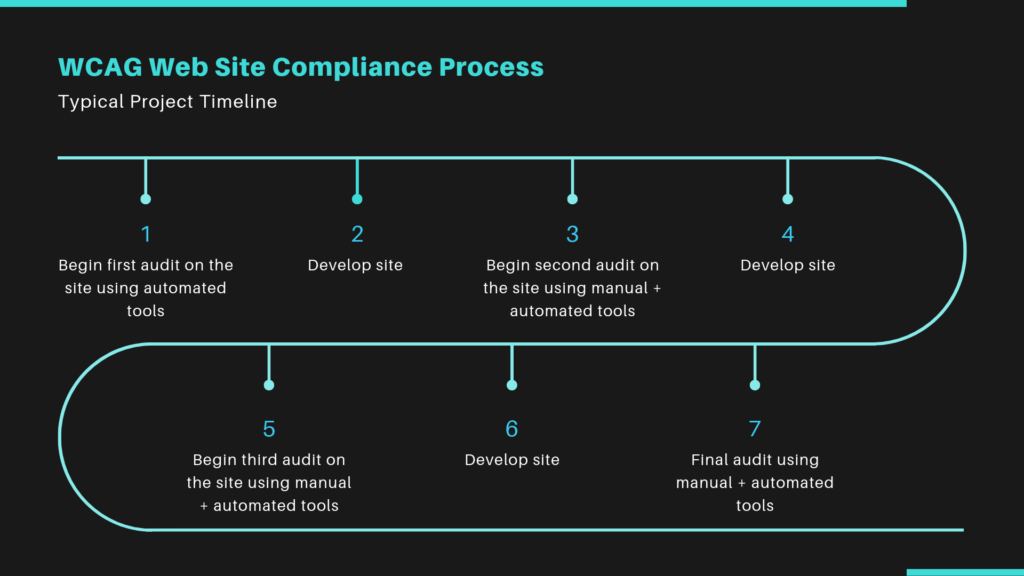If you’re wondering what Accessibility is then you’re in the right place. We are going to talk about what Accessibility means, how it impacts businesses, common accessibility issues faced by developers and lastly, how Manual Audit stacks up against Automated Testing.
Let’s jump right into it.
What is Web Accessibility?

Web accessibility, also known as Digital Accessibility, is the act of devising your website or digital platforms in such a way that they can be accessed and used by people with disabilities without seeking somebody else’s help. This involves designing your web content which includes your written content, audio visuals and digital tools, so as to accommodate disabled users to navigate, absorb and interact with your web content or website seamlessly.
Over a billion people are estimated to live with some form of disability including but not limited to blindness, deafness and a variety of others. This corresponds to about 15% of the world’s population. Web Accessibility covers any and all disabilities that could create barriers in accessing the web – such as visual, auditory, speech, physical, cognitive, and neurological disabilities.
I’m sure by now you have an idea as to why Web Accessibility is so important. These days with most of the workforce population working from home, sitting behind a screen, it has become all the more important to take into consideration everyone’s ability to access and use the digital world as they need to. This includes the disabled population.
Accessibility has grown to become an integral part of website design. Not only is it beneficial to the disabled population but it also helps businesses in many ways including reaching out to a wider audience, improving their stance on Corporate Social Responsibility and bringing down website maintenance costs.
Digital accessibility calls for a collective effort of all teams in an ecommerce development agency to come forth and work on a project from the very beginning. Accessibility needs to be incorporated into all elements including the page elements, browsers, mobile apps and the website itself. This can be achieved when everyone has a unified goal in mind they strive forward to deliver the best user experience possible.
What problems does Web Accessibility address?

Besides people with disabilities, web accessibility can help people from all walks of life have a smoother experience on the internet in many ways. Some of those ways are as follows:
1. Better Code – In order to meet demands, developers are pushed to write better code. Writing cleaner, high-quality code can benefit companies in a number of ways including faster loading times, reduced bugs, overall better user experience and boosting their SEO. Taking advantage of this factor, developers and designers must focus on creating all content keeping in mind accessibility standards and requirements which will help push their company forward in due time while improving their content.
2. People Experiencing Discomfort – A lot of times web accessibility can be a blessing in disguise for people experiencing a certain type of discomfort while browsing on the internet. Approximately 40% of adults above the age of 65 have some form of disability so take the older population for example. They may find themselves unable to read a certain type or size of text and Text-to-Speech is something they can use in this instance to access said content. For that matter, people who have lost their glasses or can’t move their arms due to an injury can also benefit from this.

3. Situational Problems – Accessibility features have proven to be a life saver in many situations where even people without any discomfort or disability have found it extremely useful. You never know who might need access to your website and what problems they might be facing while doing so. Web Accessibility ensures that all kinds of users are able to access your content and get what they need out of it.
Did you know that the disabled population spends over half a trillion dollars on healthcare annually? Astonishing how businesses fail to recognize the urgency and potential in the matter as over 72% of this population will leave a site after struggling in accessing data. The sad part is more than 85% have said that they would return to a said website to complete a transaction if it were made completely accessible but to no resolve.
As you can see the importance of making your website and all its content and elements accessible is gaining more and more importance with each passing day. In and by itself, adhering to accessibility standards set by authoritative bodies such as the WACG (Web Content Accessibility Guidelines), the ADA (Americans with Disabilities Act) and employing the 508 Compliance Checker is becoming more and more crucial. This is done to ensure that people with disabilities are not discriminated against in terms of content accessibility.
Developers and designers face many issues while creating an inclusive accessible website. Let’s have a look at what kind of problems they face before learning about how they can actually address them with the help of automated tools and manual checking.
Some common complications that are encountered herein are:
1. Insufficient Link Information – Including links in the content without providing sufficient information about where those links lead to can be a serious problem. Here screen readers are not able to comprehend what they’re hovering over or where the link will take the user. Specific information needs to be included here to help screen readers read links in a clean manner.
2. Field Labels – A lack of field labels is another serious problem that users face when visiting a new website. When forms are not integrated the right way, it becomes an annoyance for users depending on screen readers to understand and fill out fields or forms that are on the page. This leads to a lack of information input and can cause the user to abandon the website.
3. Pop-Ups – Even for normal users, pop-ups can become a real hindrance in website usability. When unrequited pop-up overlays appear on webpages which aren’t made known to the VoiceOver it can restrict keyboard users to the page with no means to exit it. This reflects poorly on the website owners which can drive down their SEO and make sure these users don’t ever return to their site.
4. Improper Headings – Headings are supposed to help users identify the part of content they most require or are looking for. Many a times, headings are not in order and are only inserted to meet an aesthetic standard, which is fine, but they must also serve the purpose they are there for which is to help users navigate smoothly. Proper headings with the right color contrast settings need to be used in order to help disabled users access all the data on the website effortlessly.
5. Lack of Alternate Texts – Alternate texts are very important in helping tools like screen readers assess your website. This measure must be implemented for all types of non-text media including images, videos, text-based images and audio descriptions. Many developers forget about the factor of inclusiveness and only make content accessible to the blind or the deaf. One must keep in mind to make content accessible for all equally and in doing so must adhere to set accessibility standards.
Such hurdles reiterate the need to scan through the content of a website more efficiently and is something that undeniably requires a human touch in web accessibility testing. This brings us to the last segment of this article – Manual Testing vs. Automated Tools.
Manual Testing vs. Automated Tools
When it comes to accessibility testing, each method – be it Manual or Automated – has its own perks and are used in different stages of development. A combination of the two is the best way to correctly asses a website, as there are tasks that a software tool cannot perform and there are also huge amounts of data that a human would need days, maybe weeks to comb through.
Automation Takes the Lead
Automated accessibility tests uses programs and tools to scan your website and bring to light accessibility obstacles. As the name suggests, this process is automatic and you can get started with just a single URL. Automated testing generally highlights the problems found in the code of your website and they’re often easy to fix given you have the right kind of knowledge for the code you’re writing.
Automated tools are usually a company’s first preference when it comes to accessibility testing since most websites are large in volume and it doesn’t make sense to deploy human resources on such a task. However, there are many areas where automation fails to deliver accurate results.
Some good examples of where automation lacks are screen reader compatibility, keyboard-only navigation, links and form fields that need to be highlighted using keyboard commands, color/contrast adjustments, smooth backed coding, navigating between sections and tabs of a webpage and detecting form errors.
Accessibility testing services must ensure that any and ALL errors are detected and checked before release or publishing content to the public. ADA compliance testing and other statutory testing authorities dictate standards that automation alone cannot meet. In such cases manual testing must be deployed.
Why Is Manual Accessibility Testing Essential?
At the end of the day these tests are conducted to ensure that people on the other end of the screen have a smooth browsing experience with ‘‘people’’ being the key word.
Coded tools are unable to understand context and hence cannot perceive data the way a human would. This requires a special human touch as there are problems that a program cannot detect such as distinguishable links, consistent seamless navigation, all-round keyboard access, correct use of sensory characters and much more.
The Final Verdict

Both methods have their own weight in the development of a fully digitally accessible website, albeit they are used at different stages. Automation Testing is best for when you launch a new site, when your webpages undergo a redesign, or when you need to conduct significant changes in the content of your webpages. It is also recommended to conduct through audits at regular intervals, which is when Automation tools are your best choice.
Manual testing, on the other hand, is best after Automation has run a deep scan and highlighted all the points that need further attention. Manual testing is required at stages right before launching a website to check for any loopholes in code, when altering any sort of input fields or changing navigational elements that have been added newly onto a webpage. Although it takes longer to conduct, manual testing will give you valuable insights that can go a long way in improving the code and content for you site.
Therefore, the crux of the matter is that in order to ensure complete accessibility of a website, it is fundamental to use both manual and automated testing judiciously.
Your website speaks volumes about the nature of your business and how you treat your customers/visitors so keeping your website up to par with accessibility standards by conducting regular assessments will not only help maintain compliance and keep your neck out water but will also ensure that your customers and visitors keep coming back.